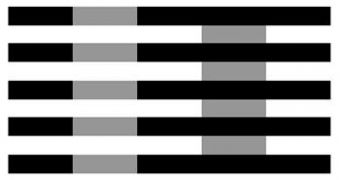Researchers have just reached a profound conclusion: machines imitating human performances will do the same errors that we do. A vision computer program based on the human brain experiences the same optical illusions that people do, pointing to the fact that the illusions are a by-product of how during the infant stage we learn to filter our complex surroundings. Future robots will have implemented the 'experiences' of our failures just to see like us.
It has been long believed that one class of optical illusions are produced from the way the brain attempts to determine the color of an object and its illumination. An object is seen as brighter or darker, either because of its shades or because it is in the light or shadow. Solving this issue would have been learned by the brain through trial and error while in the cradle, as it was believed.
This works in most cases, but sometimes our brain gets fooled, perceiving an object lighter or darker than it is in reality. This is an illusion.
This was checked by Beau Lotto and David Corney at University College London, UK, who made a program that learns to forecast the lightness of an image through previous experiences (like a human toddler). The team used 10,000 gray-scale images of fallen leaves encountered in nature, and the program had to forecast the real shade of the center pixel of the images, and shift its technique based on if its answer was right or wrong.
After that, the program was tested on lightness illusions that induce human optical illusions, like images of a light object on a darker background, and the opposite situation. The software made the same human mistake, seeing the objects as lighter or darker than they really are, even in subtle similarities: lighter shades were overestimated, compared to darker shades.
The team also checked White's Illusion, and the program detected areas of gray as darker when located on a black stripe, and lighter when located on a white stripe. Other computer models attempting to directly imitate the brain's structure made one of the two illusions, but never both at once, like humans do. But the new program was developed to make its choices through learning.
"Our ability to see illusions really is a direct consequence of learning to filter useful information from our environment. We didn't evolve to see things accurately, but to see things that would be useful.", said Lotto.
Human vision is well adapted to many environments, but robot vision trying to use its advantages will also experience its failures. The perfect, superhuman robot is prone to mistakes, just like we are.

 14 DAY TRIAL //
14 DAY TRIAL //